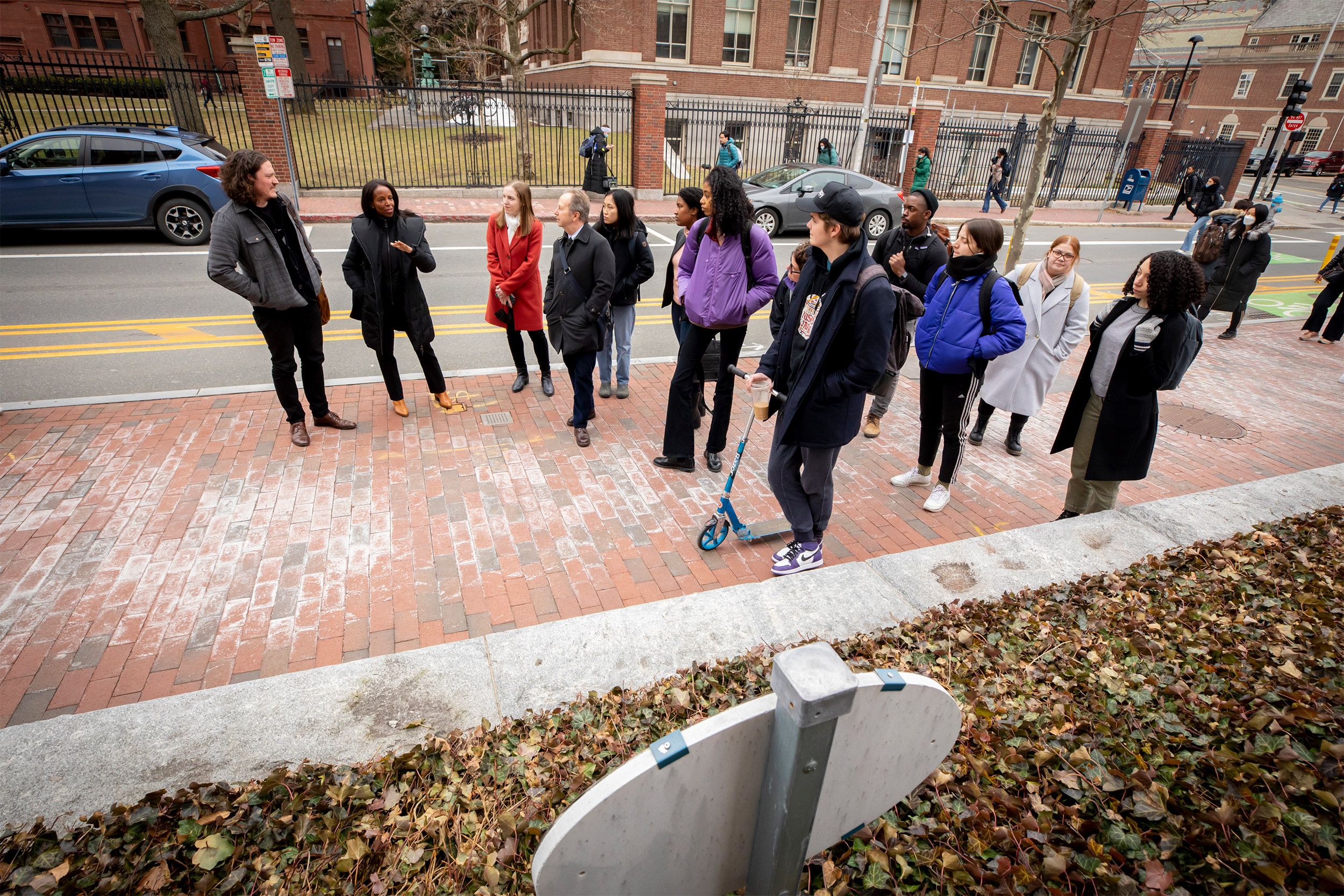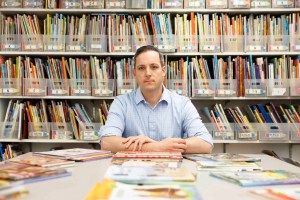
MASS Design Group Executive Director Michael Murphy (from left), Professors Sarah Lewis and Joseph Koerner (third from left) take the “Monuments” class to Quincy Street where the city of Cambridge placed a marker at the site of Louis and Elizabeth Agassiz’s home.
Rose Lincoln/Harvard Staff Photographer
Scrutinizing narratives behind nation’s monuments
New course asks students to consider who, what we are being asked to honor — and why
History of Art and Architecture Professors Sarah Lewis and Joseph Koerner have worked on the issue of monuments for years through projects like Lewis’ “Vision and Justice” course and Koerner’s film “The Burning Child.” This semester, the two joined forces for a new class called “Monuments,” which aims to prompt critical conversations about the public works of remembrance.
“The course began by asking: Why have monuments, particularly in the United States, become such points of controversy in recent years? What does the fixation on monuments in this historic moment have to teach us specifically about justice and racialized life in American democracy? The class takes as its starting point that we need to consider monuments anew to better understand the critical role they play in representational democracy,” said Lewis, associate professor of history of art and architecture and of African and African American studies.
At a time when the country is grappling with efforts to remove monuments honoring controversial American leaders such as Robert E. Lee in New Orleans and Richmond, Virginia, as well as other Confederate figures throughout the South, “Monuments” aims to provide students space to hold important conversations about the history behind the people and events being honored.
Howard Johnson ’22, a history and literature concentrator, said the class of 10 undergraduate and graduate students, as well as the former chair of the Art of the Americas collection at the Museum of Fine Arts, has encouraged students to think about how representations of history impact interactions in society and whether monuments reflect the sentiments of an entire people or the desires of specific individuals to cement certain narratives.
“The narrative associated with those monuments can either be distinct and public, or it can be hidden, you have to search for it,” he said. “Oftentimes those more hidden monuments aren’t as scrutinized and so the messages they can be sending are dangerous.”
The class analyzed the contemporary monument “Triumphs and Laments” by South African artist William Kentridge, who recounted the story behind the work via Zoom. Koerner, the Victor S. Thomas Professor of the History of Art and Architecture, described “Triumphs and Laments” as a 550-meter frieze on the banks of the Tiber River in Rome that was created by pressure washing centuries of grit from the river wall to form a row of 20-meter-high silhouettes telling the history of Rome. The piece intends to portray the narrative that monuments are “typically one person’s victory and another’s (the victim’s) lament,” Koerner said.
“Studying how this work was sited in Rome (the ‘eternal’ city often visited by ruin), and hearing the artist’s strategies, we explored new ways for monuments to make strong public statements without imposing the permanence of victor or victory,” the professor said.
There is also a tension within each monument between past and future, student Zoë Hopkins said.
“Monuments are, on the one hand, making a claim to history by attempting to commemorate something. Often this is implicated in some fantastical notion of the past or some falsehood of the past,” said Hopkins, a junior concentrating in HAA and AAAS. “At the same time, they’re making a claim to futurity and they fundamentally suggest a cognizance of future generations to come who will be looking at this monument to learn about history.”
Hopkins said “Monuments” has pushed her to reflect on time and memory, as well as how artworks and monuments might operate in the future. Besides Kentridge, Koerner and Lewis invited four other guest speakers, including Paul Faber and Naima Murphy Salcido of Monument Lab, conceptual artist Hank Willis Thomas, and MASS Design Group Executive Director Michael Murphy, to discuss monuments’ connection to memory.
Murphy, who holds a master’s of architecture from Harvard Graduate School of Design, worked with the Equal Justice Initiative to create the National Memorial for Peace and Justice in Montgomery, Alabama. The memorial includes the Soil Collection Project, which engages local communities in a reckoning with the legacy of lynching through collecting soil from the sites of lynchings and displaying them with the dates and victims’ names.
Graduate School of Arts and Sciences student Sarah Moses, who lived for a time in Georgia and is studying architecture, said she found herself searching for the distinctive red soil of Athens, Georgia, while looking at photos of the soil display. “That project is really striking, because I think we think a lot about what’s unknowable,” she said. “The name, the date, and the place are all united in this one object.”
Murphy’s presentation and the soil project led Hopkins to consider the relationship between the material landscape and histories of violence, as well as how our bodies process memory.
“Memory relates to time in a weird way. One thinks that memories are strongest when the events are most recent, and that may well be. But the public expression of memory takes a very long time,” Koerner explained. “Murphy pointed out that in Germany half a century really had to pass before monuments to the Holocaust were built. This has something to do with the way in which people process violence, the way in which people process guilt, the way in which people process feelings of anger and sorrow.”
“If we don’t have a mode of analysis for this history — of the kind that the Monument Lab has created with its National Monument Audit — we’ll be unable to have the sort of reckoning that monuments debates are asking of us now,” Lewis added.
Ultimately, Koerner and Lewis said they hope the course leaves students with important connections and inspires them to make impactful changes in the future. Students like Aziza Izamova, a HAA Ph.D. student, said the course has presented students with a possibility of action.
“I think this is a fantastic opportunity to see how things can be done. Even if we don’t do them in the next five years … it might take 10 years to have your project realized,” Izamova said. “This is a great opportunity for us to just start thinking about this now.”




